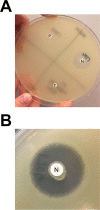Modified Carbapenem Inactivation Method for Phenotypic Detection of Carbapenemase Production among Enterobacteriaceae
- PMID: 28381609
- PMCID: PMC5527410
- DOI: 10.1128/JCM.00193-17
Modified Carbapenem Inactivation Method for Phenotypic Detection of Carbapenemase Production among Enterobacteriaceae
Abstract
The ability of clinical microbiology laboratories to reliably detect carbapenemase-producing carbapenem-resistant Enterobacteriaceae (CP-CRE) is an important element of the effort to prevent and contain the spread of these pathogens and an integral part of antimicrobial stewardship. All existing methods have limitations. A new, straightforward, inexpensive, and specific phenotypic method for the detection of carbapenemase production, the carbapenem inactivation method (CIM), was recently described. Here we describe a two-stage evaluation of a modified carbapenem inactivation method (mCIM), in which tryptic soy broth was substituted for water during the inactivation step and the length of this incubation was extended. A validation study was performed in a single clinical laboratory to determine the accuracy of the mCIM, followed by a nine-laboratory study to verify the reproducibility of these results and define the zone size cutoff that best discriminated between CP-CRE and members of the family Enterobacteriaceae that do not produce carbapenemases. Bacterial isolates previously characterized through whole-genome sequencing or targeted PCR as to the presence or absence of carbapenemase genes were tested for carbapenemase production using the mCIM; isolates with Ambler class A, B, and D carbapenemases, non-CP-CRE isolates, and carbapenem-susceptible isolates were included. The sensitivity of the mCIM observed in the validation study was 99% (95% confidence interval [95% CI], 93% to 100%), and the specificity was 100% (95% CI, 82% to 100%). In the second stage of the study, the range of sensitivities observed across nine laboratories was 93% to 100%, with a mean of 97%; the range of specificities was 97% to 100%, with a mean of 99%. The mCIM was easy to perform and interpret for Enterobacteriaceae, with results in less than 24 h and excellent reproducibility across laboratories.
Keywords: Enterobacteriaceae; antimicrobial susceptibility testing; bacterial antibiotic resistance; bacteriological techniques; carbapenemase; carbapenems.
Copyright © 2017 American Society for Microbiology.
Figures



Comment in
-
Is This the Carbapenemase Test We've Been Waiting for? A Multicenter Evaluation of the Modified Carbapenem Inactivation Method.J Clin Microbiol. 2017 Aug;55(8):2309-2312. doi: 10.1128/JCM.00538-17. Epub 2017 Jun 14. J Clin Microbiol. 2017. PMID: 28615469 Free PMC article.
References
-
- Centers for Disease Control and Prevention. 2013. Antibiotic resistance threats in the United States, 2013. Centers for Disease Control and Prevention, Atlanta, GA: http://www.cdc.gov/drugresistance/threat-report-2013/.
-
- World Health Organization. 2014. Antimicrobial resistance: global report on surveillance 2014. World Health Organization, Geneva, Switzerland: http://www.who.int/drugresistance/documents/surveillancereport/en/.
Publication types
MeSH terms
Substances
Grants and funding
LinkOut - more resources
Full Text Sources
Other Literature Sources
Miscellaneous

